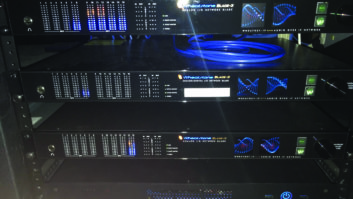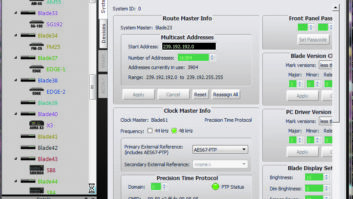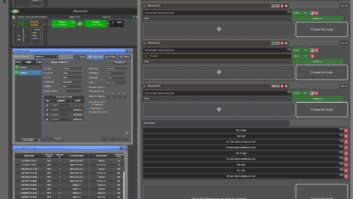Dee McVicker is affiliated with Wheatstone, which makes the WheatNet-IP audio network.
Something is clearly missing between the IP at your studio and the IP out in the wild.
On the one end, IP is crisscrossing the globe and touching smart houses, smartphones and everything in modern life.
On the other end, IP is also coursing through your studios. In its own AoIP way, it, too, is — routing audio, switching controls and making things happen.
And in between? A huge disconnect in terms of full, seamless studio operation between two or more locations.
We can talk all we want about virtual in a cloud or centralizing operations for several stations scattered across a region, but until we can connect up those two worlds, none of that is going to happen. It all comes down to solving that missing link, or more accurately, several missing links.
Let’s start with the IP audio networked studio as we know it. Here, you can move programming around via audio drivers and control various elements throughout using software and hardware logic controllers built into the IP audio network. You can trigger mics on or off, set their levels, and in the case of WheatNet-IP, sum, split, EQ and control audio from anywhere in the network and in all the ways that are unique and important to a broadcast operation.
CONTROL ACROSS THE DISTANCE
That kind of intelligent studio operation currently extends only so far, however. To reach across the ether, you have had to leave some of that control behind.
So while we have a multitude of very effective ways to port audio across many different platforms using a number of standards and protocols — AES67, MADI and AES, for example — we haven’t found an easy way to send along all the AoIP operating logic to go with it. Without that logic, you can’t do the most basic of studio functions at a distance — like turn on a mic or press a play button from 1,000 miles away. You can’t send and receive router commands, automation control or set fader levels across two locations. You certainly can’t connect two facilities from city to city. Without being able to transfer control logic, it’s impossible to switch audio locally from a regional studio on the other side of the continent or even in the next town over.
AoIP manufacturers have tried to solve this problem in various ways in the past. One promising new solution is an AoIP appliance for the WheatNet-IP audio network that includes its ACI control interface along with two other key technologies.
SwitchBlade is the first product of its kind to combine AoIP logic control with SIP connectivity and codec bandwidth optimization for transporting both high-quality programming and the control logic critical for full studio operation between sites. With this, broadcasters can extend full, seamless studio operation across the public internet. They can remotely control a console, mic or automation system from a sister facility in the next state or from a network operation center halfway across the globe.
CODECS NEEDED
Key to bridging the distance between locations is being able to transfer high-quality programming. With demanded bandwidth in the megabits/second range (1.4 megabits every second for typical stereo music) and available bandwidth over public and private IP links typically in the kilobits/second range (96 Kb/s, 256 Kb/s), we need really good codecs to give us the means to fit high-quality programming down those pipes and have it come out the other end sounding like broadcast quality.
We’ve been using and perfecting codecs for a number of years and for a number of purposes, such as downloading music to our phones, sending audio to the transmitter, even for HD radio. In broadcasting, different codecs serve different applications, which is why broadcast equipment manufacturers offer a number of different codecs for distribution and remote products. SwitchBlade, for example, includes 256 Kb/s stereo Opus, G.711, G.722 and a half-dozen other codecs.
In fact, the number of uses and types of codecs available today is staggering, which brings us to SIP. SwitchBlade uses SIP to simplify that codec selection. It has two network connections: one to connect directly into the WheatNet-IP audio network and the other for connecting to a SIP server.
SIP, TOO
SIP, or session initiation protocol, is a complete messaging protocol for initiating and terminating multimedia communication sessions. When two devices are made aware of each other via SIP, they are able to talk back and forth about bandwidth, whether audio is stereo or mono, how they will communicate with each other and the type of codec to be used to encode the audio in transit.
SIP is an important protocol used in VoIP communications for establishing audio connections over IP paths. As such, it can take the pain out of getting audio paths automatically hooked up at the best possible quality. For example, with 24 simultaneous connections available, one SwitchBlade appliance at the studio can send the same program content to six different transmitter sites, each using different SIP-compatible codec brands and settings and still have 18 more in reserve. In this way, it becomes possible for broadcasters to replace two, four, six or more encoders with one box at the studio and hang onto existing codec units at transmitter sites.
At its more advanced level, SIP-based connectivity makes it possible to transport high-quality programming to or from just about anywhere — to affiliates, from stadiums, between regional studios and across the ether to a network operation center. SIP negotiates the connection as well as the method for compressing high quality streams, freeing the broadcaster to transport programming without regard to the tedious details of routing and transport mechanisms used on the other end.
In summary, to move full AoIP studio operation across the chasm to regional or network operation centers, we’ll need our systems to mobilize AoIP control logic, establish high-quality audio connections and interoperate with the ubiquitous codecs found at large.












